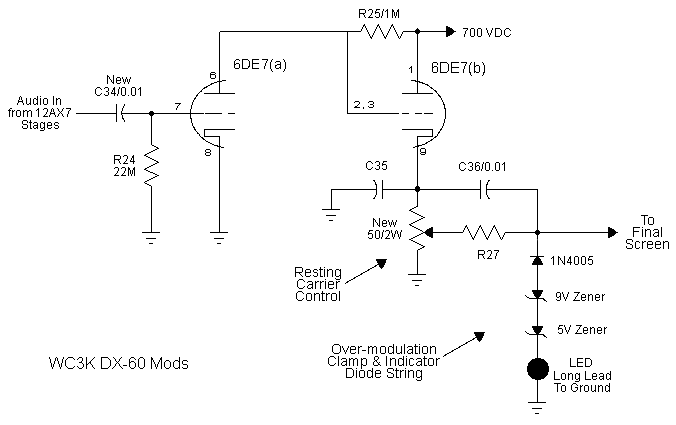The WC3K DX-60 Mods by Bill - WC3K |
The Heathkit DX-60 transmitter is a very effective AM performer when used to drive the typical high power linear amplifier. The following is the most simple and effective portion of the WC3K DX-60 Modifications, first described in the May and November 2000 issues of Electric Radio magazine. They have been extensively proven through on air operation by numerous hams since. All components, except for the potentiometer are available at Radio Shack. The low-end frequency response of the audio chain is improved by increasing the size of the interstage coupling caps, C31 (12AX7 pin 6) and C34 (12AX7 pin 1), from 0.005 uF to 0.01 uF. (Do not increase C34 further! Its value is critical to the controlled carrier performance.) The high-end frequency response is improved by removing C32 (12AX7 pin 2), the 0.001 uF between the grid and ground. The addition of a resting carrier level control to cathode of the 6DE7 modulator tube is a must for setting the power output to a level appropriate for use with a linear amp (0.3 to 10 watts). The combination negative cycle clamp and over modulation indicator limits splatter and distortion and aids in setting the correct audio level without a scope. As long as you avoid "flashing" the LED, your audio level is correct. Most hams who have already performed these mods, install the audio control and and the carrier level control on the front panel. Best performance with controlled carrier screen-grid modulation of the 6146 is obtained with sparse grid drive (1 to 2 mA) and heavy loading (150 to 200 mA with the mode switch in the CW position). In the AM mode and no audio input (resting carrier condition), a stock DX-60 will show a plate current of about 50 mA and 5 to 8 watts RF output. Power output on audio peaks will approach 50 watts but will show only slight movement on the plate current meter. With the new carrier level control, the resting carrier can be set from about 0.2 to 12 watts RF output. Audio peaks can still approach 50 watts and depend on audio gain settings to establish the desired peak envelope power (PEP). Setting the controls for an amplified resting carrier level of 100 watts output and a PEP setting of 400 to 800 watts works well, when driving a linear amplifier.
|
